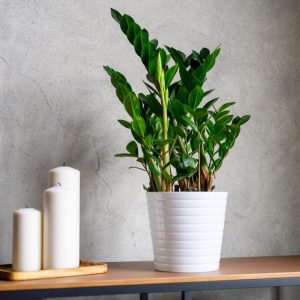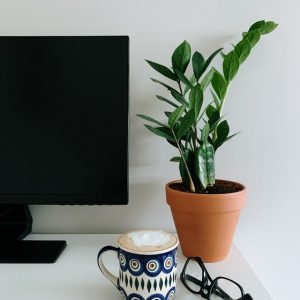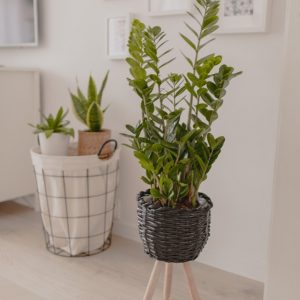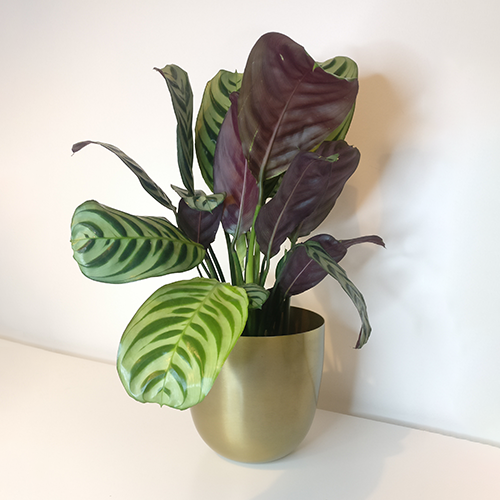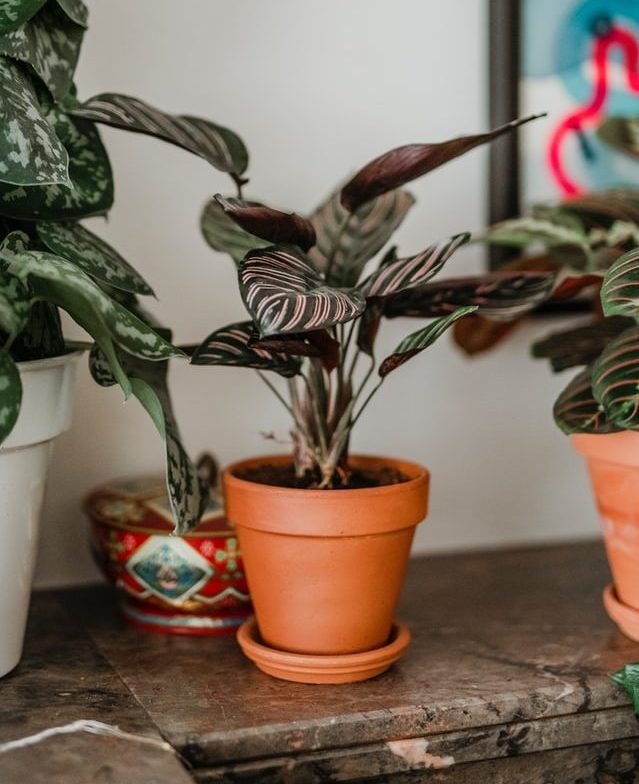All about the ZZ plant
Hard to kill
Air purifying
Not pet safe
Moderate to low light
The ZZ plant, also known as a Zanzibar gem or zamioculcas zamiifolia, is a hardy, glossy leaved plant that is incredibly hard to kill. They can live in even the lowest of lights, making them perfect for corners of the house that get little sunlight. If you’re prone to neglecting your plants or just want a low maintenance option this is the plant you’ve been looking for! A NASA study also found that the ZZ plant was able remove toxins from the air, making it an air purifying plant.
Click to skip to the section you’re looking for:
1. How to water your ZZ plant
2. The best soil for ZZ plants
3. Propagation
4. Repotting and growing
5. Styling a ZZ plant for your home

At a glance
[wptb id=2979]
How to water your ZZ plant
When it comes to watering your ZZ plant less is better. Only water your ZZ when the soil is dry when touched. To check this, stick your finger 1-2 inches into the soil and see whether the soil feels dry or wet. If it’s dry – go ahead with watering. The mantra when it comes to watering is; throughly not frequently. Directly apply water to the soil and wet throughout. Sometimes it helps to give the nursery pot a bit of a squeeze or to do this in the sink. Ensure your pot and soil is well drained, don’t let the pot sit in any water. Add some liquid houseplant fertiliser to your watering regime a few of times a year.
While it will depend on your home environment and the level of sun exposure, we suggest watering every 2-4 weeks in summer, and no more than once a month in winter.
Mantra: Water thoroughly rather than frequently
Signs of overwatering your ZZ plant
If you start to see any mushy stems or yellowing leaves than you may have overwatered your ZZ plant. This can lead to root rot and you may need to repot your plant to save it. This will involve removing any rotten roots, pruning back any damaged stems, and repotting the plant into clean, well draining soil. Click here to read our full article on repotting your plant after overwatering.
Signs of underwatering your ZZ plant
If the leaves of your ZZ plant start to shrivel or (confusingly) turn yellow, this may also be a sign of under watering. Prune away any damaged stems or leaves, and adjust your watering schedule.

The best soil for ZZ plants
When we said this plant was low maintenance we meant it! The ZZ plant does not require any special type of soil or potting mix.
Propagating ZZ plants
There are a couple of different propagation options available for the ZZ plant: water, soil, or division:
You can propogate ZZ plants using leaf cuttings or a stem cutting. Take your cuttings and place them in a jar of water, ensuring the bottom of the cutting is submegered in a couple centermeters of water. Once you see roots start to sprout, (3-6 months), take your cuttings and re-pot!
Tip: If you’re propagating in water remember to replace the water in your jar 1-2 times a week so it stays fresh.
Cut off a few leaves or stem cuttings plant these straight into soil. If you’re planning to propagate using leaves then ensure around 1/3 of the bottom of the leaf is in the soil.
Option 3 – Divide an existing ZZ plant
If you’re a little impatient of simply have a really large plant that’s getting too big for it’s pot – you can simply divide your existing ZZ plant. Remove your ZZ plant from its pot, break up the plant into more sizeable ‘chunks’ and re-pot each section into a new pot.
Repotting and growing your ZZ plant
ZZ plants have bulbous-like nodes called rhizomes with tuber roots (thick roots that act as an extension of the rhizomes). Both the rhizomes and tuber roots help store water and nutrients for the plant. In fact it’s part of the reason why the ZZ plant can survive higher levels of neglect compared to many other plants.
ZZ plants grow slow. While they can tolerate low-light, if you want to speed up the growth process then we recommend positioning your ZZ plant in an area with moderate sunlight, and where humidity is around 40-50% . New shoots will be a light lime green, turning a dark glossy green as the plant matures.
The ZZ plant generally reaches a height of around 90cms. You can usually purchase the plant in varying sizes from small (around 30cm tall), medium (around 50cm tall) and tall (90cms).
ZZ plants are toxic to ingest – so make sure they are kept away from children and pets.

If your plant is growing in size then you may need to repot to avoid it becoming root bound. When it comes to repotting your ZZ plant:
- Loosen up the roots
- If you’re planning to divide your plant – break apart the the plant at the roots. It may require some force!
- Use a well draining soil mix
Styling your ZZ plant for your home
If you’ve got a tall ZZ plant try styling this in a standalone pot on the floor. Because the ZZ does not typically ‘spray’ out like say, a monstera, it can slot into most spaces and can be used to break up an area.
If you’ve got a smaller ZZ try positioning this on a table or stand to add a splash of colour to the room without invading the immediate area. Next to the tv or on a side table near the sofa is a great location for this
Looking for ZZ plants?

ZZ Plant Gem Tall
Sold by: 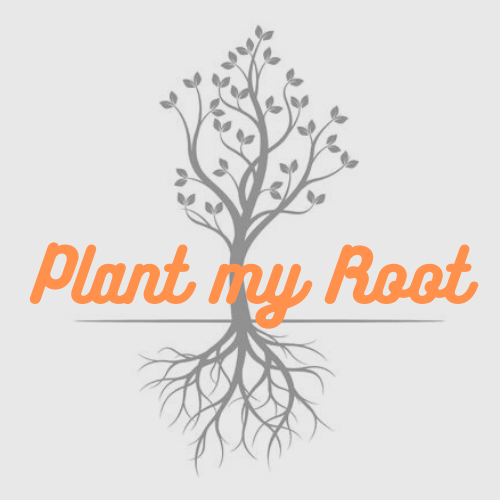 Plant My Root
Plant My Root
0 out of 5
£54.00
Add to basket

ZZ Plant Gem Small
Sold by:  Plant My Root
Plant My Root
0 out of 5
£12.00
Add to basket
